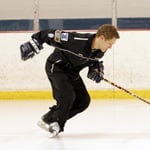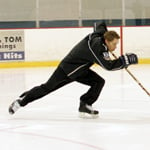
All sports utilize the elements of force application to generate movement. The elements are the same in all sports but the methods of applying them are different, and specific to each sport.
Principals of Force Application
When force is applied correctly, powerfully and explosively, with exact timing, the result is power. Power, combined with quickness (rapid motion) results in speed (of the self, of the puck, of the bat, or ball or any other object).
Most athletic motions have at least four basic elements of force application. I call them the wind up (coil or preparation), release (push, swing, throw, etc.), (full extension or completion), and weight shift.

Think of a pitcher to understand the above elements. A pitcher’s wind-up is a perfect example of the coiling action. The release and follow through and weight shift (during the pitch) exemplify properly timed force application. The result is a ball that travels with lightning speed.
Every push in skating requires the same elements
- Wind-up. The knee of the pushing leg must be strongly bent and the edge of the pushing skate must dig strongly into the ice. The body weight must be completely (100%) over the pushing leg. The knee of the skate that is prepared to glide must also be strongly bent. The ideal knee bend is 90 degrees. This means that the angle between the thigh and the shin is a right angle. The ideal angle of an edge to the ice is 45 degrees.
- Release. The pushing leg, with body weight situated over it, drives directly against the edge that is digging into the ice.
- Follow through. The pushing leg continues to push until that leg is locked and fully extended. The push finishes with the very front of the pushing edge. This final part of the push is called the "toe flick".
- Weight Shift. The timing of the weight shift is extremely important. It should begin to shift from the pushing leg to the gliding leg at the midpoint of the push. It should be completed as the pushing leg approaches full extension. Skating has one more element that may not be necessary in some other sports - the leg recovery or return.
- Return (Leg Recovery). The pushing leg must return to center under the body in preparation for the next push. If it doesn't return fully the next push suffers.
These five elements must be executed correctly and timed exactly in order to generate power, and subsequently, to generate speed. Because skating motions are not natural they must be learned and practiced. Too many skaters just "go out there and skate" and pick up bad habits which must then be un-learned and re-learned.
Today's hockey is all about Speed. If players aspire to competing at a high level of hockey, proper skating technique is imperative. The end result (power and explosive speed) is worth all the effort.
by Laura Stamm © May, 2003